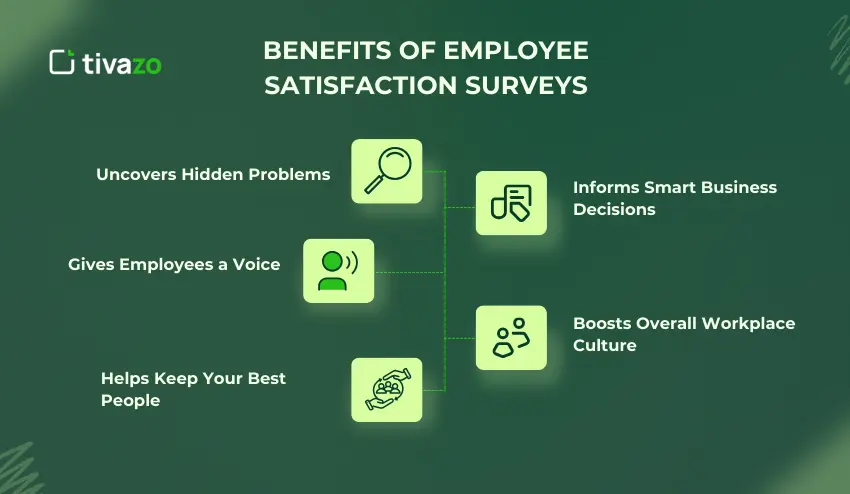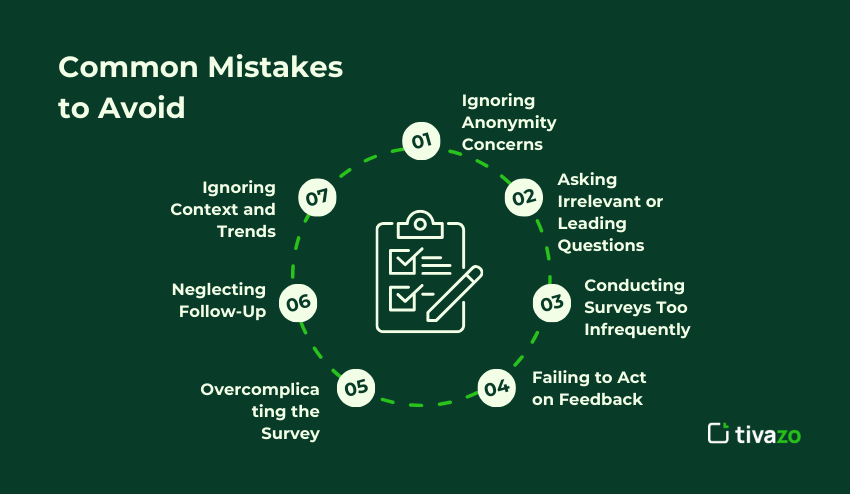Imagine a workplace where employees rarely speak up. Meetings are dominated by a few voices. Morale drops. Productivity slows. Top talent leaves.
The solution is an employee satisfaction survey. It offers an organized means of knowing employee satisfaction level towards their jobs, managers and workplace environment. By gathering this feedback, companies are able to make decisions based on actual problems rather than speculation.
This guide will include my experience on employee surveys. You will find out what an employee satisfaction survey is, its importance, how to measure satisfaction, and step-by-step ideas on how to conduct surveys that enhance engagement, retention, and workplace culture.
What Is an Employee Satisfaction Survey?
An employee satisfaction survey is a questionnaire that is used to collect employee feedback regarding their work experience. It gauges perceptions regarding the job, the management, the workplace culture, and the career development opportunities.

An employee satisfaction survey, as opposed to general engagement surveys, is designed to pinpoint areas where employees are either satisfied or dissatisfied. The difference assists leaders to act in a specific direction.
Key elements of an effective survey include:
- Anonymity: The employees should feel free to give truthful answers.
- Clarity: The questions must be easy and straightforward.
- Actionable insights: The survey should generate information that can be used to make improvements.
A properly structured employee satisfaction survey can help to identify the issues that are not visible, to show that there are opportunities to motivate employees, and to provide leaders with the confidence in their decisions. Repeated surveys make it possible to track the improvements and trends in employee satisfaction over time.
Next, we will talk about the importance of employee satisfaction surveys and the real benefits that they will have on your organization.
Benefits of Employee Satisfaction Surveys
A survey of employee satisfaction has several benefits beyond engagement measurement. It assists leaders to identify the underlying issues, provide employees with a voice, retain the best talent, and make sound business decisions.

- Uncovers Hidden Problems
It is easy to overlook small frustrations like inefficient processes or lack of clarity in communication. An employee satisfaction survey is a warning mechanism. Through these surveys, underlying issues are brought to the fore before they develop into serious problems that can drive away the best talents. - Gives Employees a Voice
A lot of employees are not ready to express concerns directly to their managers. With anonymous surveys, there is a secure, constructive avenue of candid feedback. Employees feel respected when they are listened to. This in itself can be a great boost in morale and involvement throughout the team. - Helps Keep Your Best People
It is an expense to lose great employees through recruitment, training, and lost productivity. A survey of employee satisfaction provides some of the major causes of turnover, including burnout, absence of growth prospects, and ineffective management practices. The response to this feedback will retain quality employees and create a faithful, devoted workforce. - Informs Smart Business Decisions
Data obtained through surveys provides information that results in strategic initiatives. Are you going to spend more on training? Are the benefits competitive? Is there a leadership problem in a department? An employee satisfaction survey gives clear answers, and leaders can invest in areas that will most importantly lead to employee satisfaction and performance. - Boosts Overall Workplace Culture
Employees can see when issues are identified and addressed. Morale, cooperation, and trust in leadership are enhanced. Using the findings of an employee satisfaction survey to take action will send a signal to employees that their opinions matter and will create a positive and improved workplace culture.
When all these benefits are combined, businesses can become proactive in improving engagement, turnover, and make smarter decisions that positively affect employees and organizational performance.
How to Measure Employee Satisfaction
Employee satisfaction has to be measured to see how your team feels and what needs to be improved. The most direct and reliable way is an employee satisfaction survey; however, it has to be designed and interpreted in the right way to be effective.
Here are key ways to measure employee satisfaction:
- Design Effective Surveys
Questions must be precise, short, and practical. Provide quantitative questions (rating scales) and qualitative questions (open-ended feedback). Such a combination offers quantitative information and a greater understanding of employee emotion. - Focus on Key Areas
A well-rounded employee satisfaction survey should cover:
- Workplace and culture.
- Effectiveness of management and leadership.
- Opportunities of career growth and development.
- Work-life balance
- Recognition and rewards
- Use Anonymous Responses
When anonymity is provided, employees will be more likely to provide honest feedback. This will make the results of the employee satisfaction survey accurate and representative of actual opinion. - Track Metrics Over Time
Measuring satisfaction should not be a one-time effort. Survey regularly to monitor changes, identify trends and the success of initiatives that have been undertaken after the last survey. - Include Surveys and Other Data.
Use survey data relative to retention, productivity, and employee engagement scores. This data gives a more comprehensive view of general health and satisfaction at work. - Analyze and Act on Results
The collection of data is not the end. Take action on the results of the employee satisfaction survey to fix problems, bring change and update employees. By proving that feedback leads to action, trust will be formed, and this will lead to participation in the next survey.
By systematically measuring employee satisfaction, organizations can make data-driven decisions and eventually enhance engagement, as well as provide a workplace where every employee feels appreciated and motivated.
Steps to undertake an Employee Satisfaction Survey.
The only way an employee satisfaction survey can work is through planning, clarity, and follow-through. The step-by-step method described below will assist you in gathering valuable insights and positively change:
1. Define Your Objectives
The first step is to discover what you want to achieve. General satisfaction or engagement or are you addressing specific issues like management performance or organizational culture? Clarity of objectives guides survey design and interpretation.
2. Choose the Right Survey Tool
Select a location where it is possible to be anonymous, distribute, and analyze data. The most widely used ones are SurveyMonkey, Culture Amp, or Cerkl. Ensure that the tool is appropriate to the requirements of your organization and that it is available to the employees.
3. Ask Considerate Questions.
Include a mixture of quantitative and qualitative questions. Detailed feedback should be given with open-ended questions and satisfaction should be assessed with rating scales. Keep questions straightforward, practical and pertinent to make a survey simple and of good quality.
4. Get the Purpose Across.
Before the launch, clarify to the employees the significance of the survey. Pay attention to anonymity, transparency, and the way the organization will respond to feedback. Communication improves participation and trust.
5. Distribute the Survey
Administer the survey via email, portals, or mobile applications in-house. Give employees time to perform and remind without stressing. The large number of respondents will ensure that the employee satisfaction survey reflects the opinion of the whole workforce.
6. Analyze the Results
Answer the survey when it is a closed question. Identify trends, areas of concern, and areas of improvement. Compare results with earlier surveys to determine how things have gotten better.
7. Take Action
Implement changes based on the surveys. Focus on the programs that will address the most pertinent issues, i.e., workload, recognition, or communication gaps. Responding to feedback signals employees are being listened to, which is going to provide morale and encourage interest.
8. Communicate Back to Employees
Talk about the findings of the share survey and what should be done to employees. Transparency enhances confidence and encourages participation in the subsequent employee satisfaction survey. This also helps in increasing employee engagement. The workers should feel that any change is happening because of their feedback.
9. Follow Up and Monitor Progress.
Measure change strategy enhancement and success. Regular follow-up surveys to gauge improvement, trends, and constant monitoring of employee satisfaction.
These measures will help organizations carry out a successful, effective, and transformational employee satisfaction survey, which can alter the culture of the workplace.
Common Mistakes to Avoid in Employee Satisfaction Surveys
Even an employee satisfaction survey that is well designed may fail unless specific pitfalls are avoided. Knowing these errors will help the survey provide actionable information and enhance workplace engagement in an effective way.

- Ignoring Anonymity Concerns
Employees will either provide wrong or too conservative feedback unless they are assured of anonymity. Ensure anonymity to ensure honesty. Anonymous employee satisfaction surveys give the best information. - Asking Irrelevant or Leading Questions
Confusing, irrelevant, and biased questions can distort the findings. Target areas that are directly connected to employee experience, culture, and engagement. Make questions neutral and actionable. - Conducting Surveys Too Infrequently
A single survey provides a snapshot and does not provide any trend over time. Regularly perform employee satisfaction surveys to track improvement and identify new problems. - Failing to Act on Feedback
Gathering information and not acting on it destroys credibility. When nothing changes as a result of a survey, employees take notice. Always formulate and share action plans on the basis of surveys. - Overcomplicating the Survey
Surveys that are long or complex decrease the number of people who will respond. Make surveys short, simple to fill in and specific to key areas of employee satisfaction. - Neglecting Follow-Up
The surveys should not be stopped at the data collection phase. Provide updates and follow up, make changes and monitor progress. Communicating findings and showing actual steps support the mission of the employee satisfaction survey. - Ignoring Context and Trends
The results of the surveys do not tell everything. Make good decisions and interpret data using workplace changes, outside influences, and past trends.
By preventing these errors, organizations will be confident that their employee satisfaction surveys will provide them with valuable data and assist in creating a positive, productive work culture.
Effective Employee Satisfaction Survey Questions Examples
The quality of a survey on employee satisfaction can only be as good as the questions you are using. Your survey must combine different types of questions to come up with actionable insights. Rating scales offer quantifiable information, whereas open-ended questions offer a context and reveal underlying problems. This is because a balanced survey gives you a real image of how the employees feel.
The following are the key areas that your employee satisfaction survey must include:
1. The Job Itself
These questions are about the daily duties of employees and the degree to which they consider their work meaningful. Examples include:
- Rate the importance of your work on a rating scale of 1 to 10?
- Do you believe you have the means and resources to do your job satisfactorily?
- Do you take pride in the job you perform here?
2. Management and Leadership
Managers significantly impact employee satisfaction. Understanding this relationship is key:
- Does your immediate boss give any positive feedback to you?
- Is your manager respectful and supportive of you?
- Does the leadership disclose performance and goals of the company?
3. Company Culture
This category is an assessment of the general work atmosphere and feeling of belonging:
- Do you think we have a good working environment in our company?
- Do you think your team has good teamwork and collaboration?
- Do you feel that the company is practicing its core values?
4. Career Growth and Development
Employees want to see a clear future. Questions here assess opportunities for advancement and professional development:
- Would you have a good career future in this company?
- Do you feel that you have the opportunity to develop professionally?
- Has your manager talked to you about your career goals over the last six months?
5. Compensation and Benefits
While not always the top factor, fair pay and benefits influence satisfaction:
- Would you say that you are being fairly remunerated?
- The question is, are you well aware of the benefits package you are offered?
- How do you rate our benefits package compared to that of other companies?
An employee satisfaction survey that is organized to be able to capture these categories provides organizations with a full picture of the employee experience. Gathering answers is not the end; it is the analysis of the information and the ability to act on knowledge that leads to a significant increase of engagement, retention, and work culture.
Conclusion
An employee satisfaction survey isn’t a feedback tool; it isn’t a measurement of your workforce, it is a decision tool that organizations can use to understand their workforce, dive deep into issues, and make real change happen. If organizations can use measurements of satisfaction, give their employees a voice in the workplace, and follow up on the feedback, they can increase morale, retain their best and brightest talent, and make better decisions for their organization.
Surveys should be handled with care, results should then be analyzed, and organizations should take definitive action so that employees can feel valued and engaged. Each step of the way, if done increasingly well, employee satisfaction surveys help cultivate workplace culture, increase productivity, and empower each individual to thrive.
Organizations should implement surveys on a set schedule, take action, and then communicate openly with their teams. This will yield real change that strengthens and makes organizations more resilient and successful.




